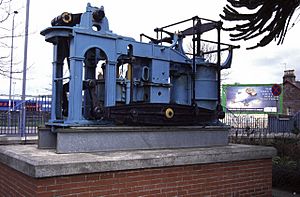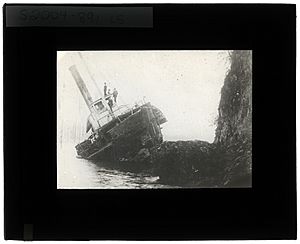Beaver (steamship) facts for kids

Beaver about 1870
|
|
Quick facts for kids History |
|
|---|---|
| Name | Beaver |
| Builder | Wigram & Green, Blackwall Yard, London |
| Laid down | London, England |
| Launched | 9 May 1835 |
| In service | 1835-1888 |
| Fate | Wrecked 25 July 1888 |
| General characteristics | |
| Type | Sidewheel paddle steamer |
| Tonnage | 109 tons |
| Length | 101 ft 9 in (31.01 m) |
| Beam | 33 ft (10 m) |
| Draft | 8 ft 6 in (2.59 m) |
| Propulsion |
|
| Sail plan | Brigantine |
| Armament | 4 brass cannons |
The Beaver was a special steamship that belonged to the Hudson's Bay Company. It was the very first steamship to operate in the Pacific Northwest region of North America. This amazing ship helped people reach faraway parts of the west coast of Canada. It made it easier to trade furs by sea.
For a while, the Royal Navy even rented the Beaver to help map the coastline of British Columbia. The ship served off the coast from 1836 until 1888, when it was unfortunately wrecked.
Building and Its First Journey
The Beaver was built in Blackwall, England. It was made from strong British oak, elm, greenheart, and teak wood. Its parts were held together with copper. The ship was about 101 feet (31 m) long. The width over its paddle wheels was about 33 feet (10 m).
The Beaver was launched on May 9, 1835. It left London on August 29, led by Captain David Home. For its long trip, the Beaver was set up like a sailing ship called a brig. Its paddle wheels were taken off. It sailed all the way around Cape Horn at the southern tip of South America. After stopping at the Juan Fernández Islands and Honolulu, it reached the Columbia River on March 18, 1836. On April 10, it anchored near Fort Vancouver. There, its paddle wheels, boilers, and engines were put back together.
Years of Service
The Beaver helped the Hudson's Bay Company connect its trading posts. These posts stretched from the Columbia River all the way to Russian America (which is now Alaska).
The ship played a big part in keeping British control in British Columbia. This was especially true during the Fraser Canyon Gold Rush in 1858–59. In 1862, the Royal Navy rented the Beaver. They used it to explore and map the coast of the Colony of British Columbia. It also helped the Royal Navy during the Chilcotin War.
The Beaver helped start coal mines at Fort Rupert and later in 1853, at Nanaimo. It also helped the Hudson's Bay Company set up Fort Victoria as a trading post in 1843. The ship often carried important people, like the Governor. It took them between the Colony of Vancouver Island and the mainland.
Over time, the Beaver's engines were updated. Its original boiler used seawater, which caused problems. The salt water would rust the boiler walls. This meant the Beaver needed a new boiler every seven years or so.
In its later years, the Beaver used coal for fuel. Young men from the Skwxwu7mesh (Squamish) community in North Vancouver worked on the ship. They helped load coal into its holds. The Hudson's Bay Company finally sold the Beaver in 1874.
The Ship's Final Days
A group of companies bought the Beaver in 1874. They used it as a towboat. But on July 25, 1888, something went wrong. The crew made a mistake, and the ship ran aground on rocks. This happened in Burrard Inlet at Prospect Point in Vancouver's Stanley Park.
The wreck stayed there until July 1892. Then, the waves from a passing steamer named Yosemite caused it to finally sink. Before it sank completely, many people took parts from the wreck as souvenirs.
Today, the Vancouver Maritime Museum has some parts of the Beaver. These include its boiler and two drive shafts from the paddle wheels. One shaft was brought up in the 1960s. The other was returned from a collection in Tacoma. There is also a plaque at the site where the ship sank. Divers explored the wreck in the 1960s. However, when the Underwater Archaeological Society of BC checked it in the 1990s, they found that most of the ship had fallen apart because of rot and strong currents.
Images for kids
-
Plaque commemorating Beaver in Stanley Park, Vancouver.




